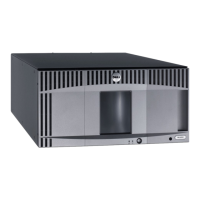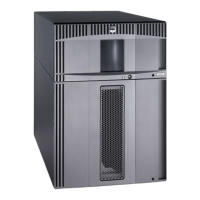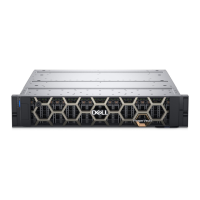Configuring Your Library
file:///T|/htdocs/stor-sys/ML6000/en/html/ch04.htm[9/17/2012 1:49:29 PM]
than six, the 5U Library Control Module I/E station may be configured automatically as storage.
• If the I/E station is configured as data storage slots, its door is always locked. For information on unlocking I/E
stations, see
Locking and Unlocking the I/E Stations.
• I/E station slots are shared by all partitions within a library.
• To identify how a specific I/E station magazine is configured, view the Library Configuration report available from
the Reports menu on the Web client. See
Viewing the Library Configuration.
Configuring Zero I/E Station Slots
Configuring zero I/E slots increases the number of storage slots in your library but has the following consequences:
• You will not be able to use the I/E station to import and export tape cartridges, including cleaning media.
• You will be required to open the library access door to bulk load and unload tape cartridges, disrupting library
operations. See
Bulk Loading.
• You will not be able to manually clean tape drives with a cleaning cartridge.
For more information on using the I/E station to import and export media, see
Running Your Library.
Caution: Configuring I/E station slots with cartridges already loaded compromises data security. First, remove
cartridges from the I/E station and then configure the I/E station slots.
Note: This operation cannot be performed concurrently by multiple administrators logged in from different locations.
You can access the screen, but you cannot apply changes while another administrator is performing the same
operation.
The paths to open the appropriate screens are as follows:
• From the Web client, select Setup > I/E Station Slots.
• From the operator panel, select Setup > Partition Mgmt > Configure I/E Station Slots.
Setting Tape Drive Parameters
Administrators can view and modify certain tape drive parameters. You can set the SCSI ID for a SCSI-attached tape drive.
You can set the loop IDs, topology connection mode, and interface speed for a Fibre-attached tape drive. You can view but
not set parameters for SAS tape drives. A SAS tape drive's SAS address is automatically and uniquely generated based on a
unique World Wide Node Name (WWNN) that the drive receives when it is configured.
If the affected partition is online, it will be taken offline before the parameters are set, and brought back online after they are
set.
Each device on a SCSI bus, including the host bus adapter (HBA) needs to have a unique SCSI ID. Changing the SCSI ID is
necessary when there is a duplicate ID on a single bus. Typically, the HBA SCSI ID is set to 7. For example, if two tape drives
are connected together on the same bus, each tape drive must have different SCSI IDs and they must be different from the
HBA SCSI ID.
For SCSI tape drives, you can set the SCSI ID to a value from 0 to 15. The library assigns the following default SCSI IDs to
SCSI tape drives:
• 5U Library Control Module: 1 and 2
• Each 9U Library Expansion Module: 3, 4, 5, and 6
For FC tape drives:
• The loop ID can be set to a value from 0 to 125. A unique loop ID is selected by default for all FC tape drives installed
in the library. For example, the tape drive installed in the top drive bay of a 5U Library Control Module is assigned a
default loop ID of 61. The tape drive installed in the 5U Library Control Module's bottom drive bay is assigned a default
loop ID of 63.
If you change the default loop IDs, make sure each FC tape drive with a topology setting of Auto (LN), Loop (L), or
Auto (NL) has a unique loop ID.
You cannot change the Loop ID if the Topology is set to Point to Point.

